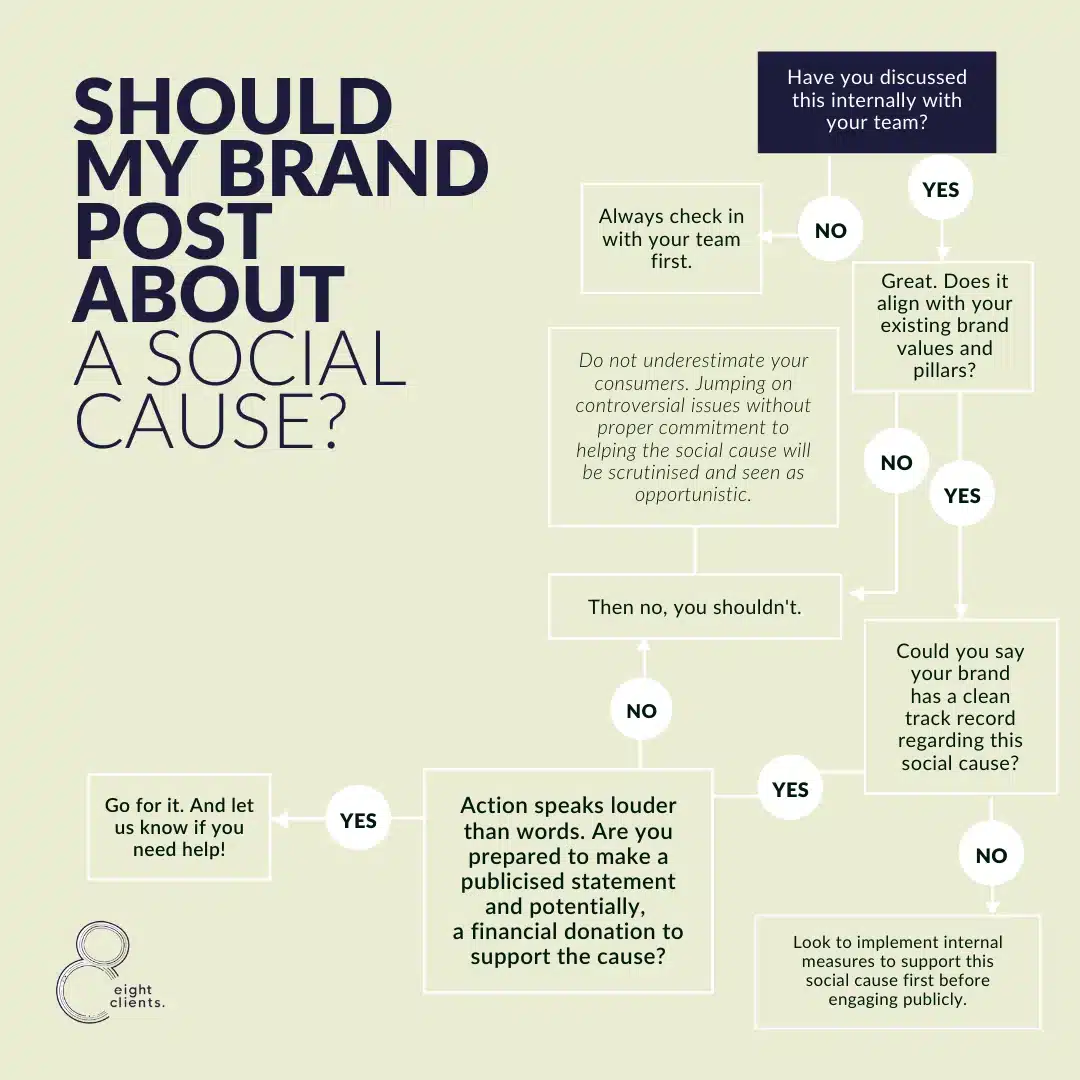When the Black Lives Matter movement exploded across social media, many brands were caught off-guard. It’s a great case study, and a moment to reset and relearn how to interact with causes as a brand.
Many brands (and white people) threw up a black square in solidarity and tried to express their support in the way they could. Because anyone with a half a heart and/or brain is enthusiastically supportive of racial justice. But the backlash against brands whose posting was seen as empty opportunism was swift.

The BLM moment posed a problem for brands on social media, where they trade in cultural and social relevance. Do you go quiet and wait for the moment to pass? There the risk is seeming out of touch or not supportive.
Do you, instead, make a heartfelt and well-meaning statement of solidarity? Here, the risk is being perceived as cynically trying to capitalise on the movement.
There isn’t a straightforward and clear-cut answer. At the time, we created a handy flow-chart that was partly a dig at out-of-touch brands, but mostly was a genuine problem-solving tool.
Here, we’re going to expand on this and add some extra context and tips so that you can feel more equipped to interact with social causes in the future. It’s important to recognise that brands aren’t always a welcome part of the social media landscape. So that’s rule #1.
Rule #1: This is your audience’s space and you’re a guest in it.
So be a good guest. Don’t impose your needs and wants onto your hosts. Instead, try to let them take the lead. In other media, there’s an unspoken contract between the broadcaster and audience that advertising and brands are integral to the space. In some, like fashion magazines, they are enthusiastically welcomed.
We can forget, as marketers, that this isn’t the case in social media. This space is an incongruous and uneasy mix of personal connections, social and political advocacy, breaking news, doomscrolling, and entertainment.
While, structurally, it’s not entirely correct, it’s important to think of brands as uninvited interlopers. Ok, so you’ve accepted that, and you’re working on providing genuinely useful content for a defined audience.
Engagement is good, click throughs are good, you’re not a regular brand, you’re a cool brand. Then a social cause explodes on the internet and, to stay relevant, you have to respond.
Rule #2: Talk about it internally first.
As the saying goes: your brand isn’t who you say you are, it’s who your others say you are.
And the best arbiters of that are the people who interact day-in, day-out with your customers and audiences. So have broad discussions beyond the marketing teams.
Start with the people who are talking with your audiences: the community managers, customer service staff, salespeople. Get their honest opinions on what they think your customers and social media audiences are feeling and thinking. Then broaden it out.
If it’s a huge social issue, you’re likely to find that it affects everyone in your team. So find a way to really listen. Now do something that is usually antithetical to good marketing: take the opinions and beliefs of your staff as fact.
They don’t need to prove how and why they feel the way they do, they just need to tell you what they think you should do. Do this across the organisation. Pay particular attention to those who are personally affected by the social movement.
But don’t put the onus on them to make the decision for you! So you’ve talked about it internally and you have a clear picture of what your staff thinks and feels.
Rule #3: Only post about a cause if it clearly aligns with your values.
We recently helped a fashion brand deal with a social media crisis. In short, they were being called out for a lack of diversity on their feeds and in their ways of working. ‘Of course we value diversity!’ the director said to us privately. It felt unfair to her that she was being called out for something that she already was working towards.
But the reality was that her audiences weren’t aware of this value and commitment. It wasn’t clearly communicated in the brand’s behaviour online. So only post about a social cause if it makes sense in the context of what you value and what you already post.
If your brand values racial justice, and you’ve been out there talking about it, then posting about Black Live Matter might make sense. Here’s the thing though: if you have to ask the question, are you really living those values?
This isn’t an easy rule to digest and turn into action. For example, IBM has industry leading inclusion and diversity programs. In fact, the company is often studied in business schools, because what they do in the space is seen as best-practice. Internally and, to a certain extent, externally they have been seen to live those values.
Still, Xavier, one of our account managers and a gay man, finds it really uncomfortable that IBM often makes their logo rainbow during Pride Month.
For him, the brand is being opportunistic. Social media posts making fun of people and brands who posted black squares and then said nothing else about it have started going viral.
That’s not the kind of viral you want. Even if you don’t get called out for posting about a social issue, you may end up harming your brand equity by being seen as jumping on a bandwagon. Whether it’s due to cynical opportunism or cluelessness, it’ll harm you.
Rule #4: Your brand should only post about a social issue if it has a clean record on it.
We all hate those BP ads where the company tries to convince us that they are committed to climate action, and are on the forefront of turning the world economy green. It’s stupid. It’s cynical. It’s self-evidently false.
How stupid do they think we are? If your brand wants to post about BLM, but hasn’t ever used models of colour and has a terrible track record of hiring and promoting people of colour, sort that out first.
You can still respond to the moment, but that response should be internal. It’s really tempting for marketers to immediately promote the good things that your brand is doing, but you’ll look like a fool if you promote redressing the structural inequities in your business as if it’s just another good news story.
And here’s where we talk about social causes and corporate social responsibility. Businesses are still working out how they integrate CSR into their work. To be perfectly blunt, most do it badly.
That is, they do the bare minimum of social good and promote the hell out of it. Some brands spend more promoting their CSR programs than they spend on the actual programs.
If you view social causes and CSR through the lens of brand-building, you’re asking for trouble. That’s our point of view, at least. You should be doing good in the world, or at least making sure that you don’t do harm, because it’s the right thing to do. Consumers expect it. Social media audiences demand it.
So, if you don’t have a clean track record in relation to the social issue that’s dominating Instagram, maybe don’t invite scrutiny by posting about it.
Rule #5: Actions speak louder than words.
The cliche of social media is that it’s full of disingenuous ‘virtue signalling’. So what you do is far more important than what you say. Your audience will check the receipts. They’ll go through your feeds, they’ll look on your website, they’ll look you up on public registers.
If you’ve satisfied all the other rules, then go ahead and post about the social issue. But put your money where your mouth is. Can you make a donation to a grass-roots organisation? Maybe your ‘money’ is finding a way to amplify the voices of social activists by giving them control of your account for a week. That’s what happened for #sharethemic.
The point is to find a way to make it more about the cause than it is about you. Rather than inserting yourself into the social activism, find a way to help it along. One of our clients, a nutrition science company, wanted to post about the BLM movement.
That led to a really honest internal conversation about why they wanted to post and whether they were really doing anything worth posting about. Eventually, they decided to ‘Pay the Rent’ by pledging 1% of their income to a local First Nations organisation. Only then did they feel comfortable making a post, which they framed as a list of ways to help the movement as an ally and an encouragement to join them in paying the rent.
So what do I do if I shouldn’t post about a social cause?
It’s a great question, and it’s often followed up by: will I look stupid if I don’t post about this social cause? Well, best practice will look different for every individual moment. The first thing to do is to listen.
BLM activists were very clear about what they wanted white-dominated businesses to do: pull up or shut up.
So, in this instance, the right thing to do would have to simply stop posting for a little while. When a movement is so widespread, sometimes that’s the answer. When to start posting again would be another vexed question.
As a general rule, it depends how invested your audience is in the movement. If it’s a blip for them, then maybe a week is enough. Alternatively, if you run a brand that has a really bad track record, and you’re not willing to redress that, maybe go to ground for longer.
Maybe you’re a media company that provides much needed comedy and escapism. In this case, you can probably start posting again sooner than most; but only if you do so sensitively. If you have any questions or feedback, we’d love to hear them! Shoot us a message. We love messages.






